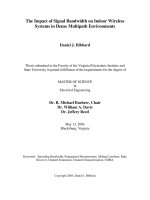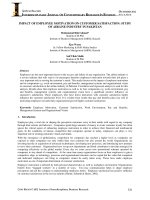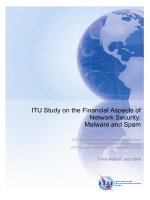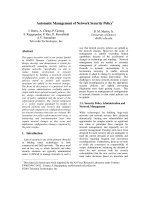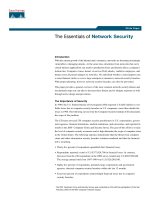CESNET Technical Report 13/2008 Impact of Network Security on Speech Quality pot
Bạn đang xem bản rút gọn của tài liệu. Xem và tải ngay bản đầy đủ của tài liệu tại đây (577.01 KB, 10 trang )
CESNET Technical Report 13/2008
Impact of Network Security on Speech Quality
M V
Received 3.12.2008
Abstract
is technical report deals with impact of secured network environment on speech qual-
ity. ere are presented the results of the analyzing of voice over secure communication
links based on TLS, specially in OpenVPN solution. e using of secure network envi-
ronments can affect a speech quality. ere is the performance comparision of cipher
alghorithms and description how the used security mechanisms influence the final R-
factor. e presented results are based on experiments which have been performed in
real IP network.
Keywords: TLS, OpenVPN, E-model
1 Introduction
e security becomes a necessity of current corporate networks and two solutions
appear either based on IPsec or TLS and therefore, this topic has been chosen for
our research in area of speech quality. e research regarding to Voice over IPsec
has been performed at University of Milan [1], so I decided to focuse on TLS. To-
gether with my colleagues from Milan we realized our real platform, in order to
understand how the voice services in IP network are affected by using the secure IP
environment. e real performance test was implemented between VŠB-Technical
University of Ostrava and University degli studi of Milan. We pointed out the ad-
vantages and the disadvantages of the adopted security measure. We described two
virtual testbed, one developed using a traffic emulator and the second one based
on a network simulator. Both the virtual environments were implemented in secure
and insecure way. e executed measurements proved the obvious impact of some
secure solutions on the voice quality, the results has been published [2] but with-
out an exact calculation. A method of calculation describing the overall impact of
security on speech quality is published in this technical report, the method is valid
for TLS and has been tested with OpenVPN.
Virtual Private Network (VPN) is a technology to construct a private network
over public networks. OpenVPN is one of the most popular soware-based VPN
products and has high flexibility. e usability of OpenVPN is high because offers
a open-source, cost-effective and widely tested solution, not requiring expert knowl-
edge. Soware VPN products are popular, because they don’t need any appliance
and OpenVPN provides such solution which is based on matured protocols. e
OpenVPN security model is based on SSL (Secure Socket Layer), the industry stan-
dard for secure communications via IP network. OpenVPN implements transport
secure network extension using the TLS protocol (Transport Layer Security).
On the other side the using of OpenVPN increases an overhead which is af-
fected byencryption and thisoverhead can influence overall speech quality [3]. is
©CESNET, 2009
2 M V
paper contains a description of OpenVPN and its possibilities regarding a config-
uration, than there is explained a core of the matter which is the splitting of a RTP
packet to equally divided blocks.
2 OpenVPN and encryption
TLS ensures a secured connection which is encrypted and decrypted with the keys
negotiated during a phase of keys exchange. e key exchange and authentica-
tion algorithms are typically public key algorithms but subsequent data exchange
is usually done by symmetric ciphers because of considerably faster processing. Of
course, symmetric encryption is more suitable for IP telephony and this paper deals
only with this type of ciphers [4]. TLS involves three main phases such as negoti-
ation of supported algorithms, keys exchange and authentication and in the end
symmetric encryption of transmitted data.
e endpoint establishing VPN tunnel are declared one as server and the other
as client. Before establishing the VPN, the client first reaches the server on a spe-
cific port, whereas the server doesn’t need to reach the client. Configuration files
are located in directory /etc/openvpn as server.conf or client.conf. e tunnel can
be established on UDP or TCP, unfortunately TCP protocol is more widespread
although UDP is more effective because of real-time applications. e most im-
portant information in configuration files is the type of cipher alghoritm because it
affects the number of blocks and overhead as is shown in Figure1.
Figure 1. e number of blocks affected by CBC mode.
Impact of Network Security on Speech Quality 3
Figure1 above illustrates the splitting of one RTP packet to N blocks. Every
block has the same lenght which contains in case of AES (Advanced Encryption
Standard) 128 bits although the key size can be not only 128 bits, but also 192 or 256
bits. If another alghoritms are applied such as DES (Data Encryption Standard),
Triple DES or BF (Blowfish), then the block size is set to value 64 bits. A complete
list of supported cipher alghoritms can be obtained as a result of command openvpn
–show-ciphers. e following ciphers and cipher modes are available for use with
OpenVPN. Each cipher shown below may be used as a parameter to the –cipher
option.
DES-CBC 64 bit default key (fixed)
RC2-CBC 128 bit default key (variable)
DES-EDE-CBC 128 bit default key (fixed)
DES-EDE3-CBC 192 bit default key (fixed)
DESX-CBC 192 bit default key (fixed)
BF-CBC 128 bit default key (variable)
RC2-40-CBC 40 bit default key (variable)
CAST5-CBC 128 bit default key (variable)
RC2-64-CBC 64 bit default key (variable)
AES-128-CBC 128 bit default key (fixed)
AES-192-CBC 192 bit default key (fixed)
AES-256-CBC 256 bit default key (fixed)
e default key size is shown as well as it can be changed with the –keysize di-
rective, using a CBC mode is recommended. CBC means Cipher-block chaining,
in this mode of operation, each block of plaintext is XORed with the previous ci-
phertext block and aerward is encrypted, that is why an initialization vector IV
must be used in the first block, see Figure1.
3 Used techniques of measurement
e presented results are based on series of measurements which has been per-
formed in real network with OpenVPN and IxChariot
1
, a scheme is shown in Fig-
ure2.
Whole traffic carried out between OpenVPN client and server was captured
by Wireshark and individual packets were analyzed. IxChariot is a soware, pro-
duced by Ixia, which consists of the IxChariot console and IxChariot endpoints.
e IxChariot console allows a selection of several test configurations, such as the
used codec, timing, number of concurrent calls, test duration and so on. e test
is initialized at the console, the conditions are uploaded into endpoints and conse-
quently the test is performed. e results are sent back to the console. ere was
observed an influence of OpenVPN-TLS on overhead which has been increased and
hence the required bandwith has been affected.
1
/>4 M V
Figure 2. Logical scheme of testbed.
4 Bandwith requirements
e basic steps of speech processing on a transmission side are encoding and pack-
etizing [5], [6]. RTP packets are sent in dedicated times and a difference between
them depends on timing. is process of packetizing is given by the following basic
equation:
(1)
where Δt [s] is timing in seconds, P
S
[b] is a payload size and C
R
[bps] rep-
resents a codec rate. e timing can be derived from content of RTP packet as a
difference of two consecutive timestamps, see Equation2. Typical value of a sam-
pling frequency is 8 kHz.
(2)
It is necessary to express the packet size at application layer which might be
defined by the following formula:
(3) S
AL
= H
RTP
+ P
S
where S
AL
[b] is the expected size that consists of a RTP header H
RTP
[b] and
a payload size P
S
[b]. Equation4 determines the size of the S
F
[b] frame at the link
layer.
(4)
S
F
[b] includes a packet at the application layer and the sum of lower located
Impact of Network Security on Speech Quality 5
headers of the OSI model where H
1
[b] is media access layer header, H
2
[b] internet
layer header and H
3
[b] is transport layer header.
Figure 3. Bandwith as a function of payload size and concurrent calls.
Figure3 illustrates the relation between bandwith, payload size and number of
concurrent calls.
(5)
In Equation5 we expressed total bandwith BW
M
[kbps] required in case of M
concurrent calls. If we now apply Equations 1, 2 and4 to Equation5, we obtain
the following result:
(6)
We have to realize that TLS is located between two layers of OSI model, be-
tween application and transport layer and therefore we apply S
TLS
instead of S
AL
.
is replacement should be done in respect of explained location of TLS and we
define a new parameter S
TLS
, size at TLS layer. S
TLS
is expressed in Equation7.
(7)
where we used the ceiling function which gives the smallest integer greater than
or equal to its argument:
(8)
6 M V
e ceiling function was defined by M. Schroeder in 1991 [7] and the symbol
was coined by K. Iverson in 1994. e parameter B
S
represents a block size which
has been explained in Figure1, its value is 64 or 128 bits and depends on applied
cipher alghoritm (AES, DES, Triple DES or Blowfish). C
0
is a constant and equals
to zero in case of clear TLS unfortunately OpenVPN adds supplementary overhead
that is included in C
0
. e value has been achieved by performing experiments, see
Figure2. We can claim that this constant C
0
is 83 bytes in case of block size 128 bits
and 75 bytes in case of block size 64 bits.
5 Achieved results
Relations stated in previous chapter have been confirmed by experiments, Figures
4 and 5 illustrate how required bandwith is affected by TLS and OpenVPN.
Figure 4. Comparision of bandwith for codec G.729 without TLS, with TLS and
OpenVPN, B
S
=64 bits
e first column of Table1 contains codec G.729 and both variants of G.723.1.
Block size has a length either 64 bits or 128 bits. Table1 provides the results for
Ethernet without TLS, with TLS and with OpenVPN [8], [9].
6 Impact on R-factor
Lack of bandwith causes a loss in the first place hence the estimation of its impact
on R-factor is explained in this chapter. e maximum value of R-factor for nar-
rowband codecs is 94, the overall quality (R-factor) is calculated by estimating the
Impact of Network Security on Speech Quality 7
Figure 5. Comparision of bandwith for codec G.711 without TLS, with TLS and
OpenVPN, B
S
=128 bits
signal to noise ratio of a connection (Ro) and subtracting the network impairments
(I
S
, I
D
, I
E−EF
) and by adding Advantage factor A.
(9) R = R
0
- I
S
- I
D
- I
E−EF
+ A
e first item R
0
is derived from original SNR, the second I
S
considers non-
optimum sidetone, quantizing distortion, overall loudness and other impairments
which occur more or less simultaneously with the voice transmission. e delay
impairments are included in the parameter I
D
as a mathematical summary of trans-
mission delay, talker echo and sidetone. e effective equipment I
E−EF
is an equip-
ment impairment that considers the influence of used codecs and impairments due
to packet loss and rejection. e packet loss distribution can be modelled using a
Markov process. A multi-state Markov Model is used to measure the distribution of
lost or discarded packets or frames, and to divide the call into “bursts” and “gaps”.
e call quality is calculated separately in each state and then combined using a per-
ceptual model, such as in VQmon [10]. e mentioned VQmon does incorporate
G.107 compliant implementation of the E-Model. However, I applied a very sim-
ple method described in the last revision of G.107 from 2005 [11]. e impairment
factor values I
E
under packet-loss were tabulated for particular codecs. Robustness
Factor B
pl
is defined as codec-specific value and can be described as the robustness
of the codec to packet-loss. Both values are listed in Appendix I of ITU-T G.113
and are available for several codecs. If we consider the Packet-loss Probability as
P
pl
, the I
E−EF
impairment factor can be calculated using the formula:
8 M V
Table 1. Values of required bandwith for various environments
codec block size timing [ms] w/o TLS BW [kbps] w TLS BW [kbps] w OpenVPN BW [kbps]
[bits] [ms] [kbps] [kbps] [kbps]
G.723.1/6,3 128 30 24 30,4 52,53
G.723.1/6,3 128 60 15,2 17,33 28,4
G.723.1/5,3 128 30 22,93 26,13 48,27
G.723.1/5,3 128 60 14,13 17,33 28,4
G.723.1/6,3 64 30 24 28,27 50,4
G.723.1/6,3 64 60 15,2 17,33 28,4
G.723.1/6,3 64 30 22,93 26,13 48,27
G.723.1/6,3 64 bits at block 60 14,13 16,27 27,33
G.729 128 10 60,8 78,4 144,8
G.729 128 20 34,4 39,2 72,4
G.729 128 30 25,6 30,4 52,53
G.729 128 40 21,2 26 42,6
G.729 128 50 18,56 20,8 34,08
G.729 128 60 16,8 19,47 30,53
G.729 64 10 60,8 72 138,8
G.729 64 20 34,4 39,2 72,4
G.729 64 30 25,6 30,4 52,53
G.729 64 40 21,2 24,4 41
G.729 64 50 18,56 20,8 34,08
G.729 64 60 16,8 18,4 29,47
(10)
BurstR is the so-called Burst Ratio, when packet loss is random BurstR=1 and
when packet loss is bursty BurstR>1. For packet loss distributions corresponding
to a 2-state Markov model with transition probabilities p between a ”found” and a
”loss” state, and q between the ”loss” and the ”found” state, the Burst Ratio can be
calculated as:
(11)
Once the I
E−EF
factor is calculated, it is not difficult to determine R-factor as an
output of E-Model using implicit values of recommendation ITU-T G.107, which
are R
0
=94,7688, I
S
=1,4136 and A=0. Hence the Equation9 can be modified to
(12) R = 93,3553 - I
D
- I
E−EF
e model used to estimate I
D
is described in [12], where it is explained that
the effects of delay are well-known and easily modelled. Delays of less than 175ms
have a small effect on conversational difficulty, then I
D
=4T where T is the delay in
ms.
Impact of Network Security on Speech Quality 9
7 Conclusion
e real-time applications are very sensitive to packet loss, and each variation oc-
curring on the network can modify and influence the final result of a real-time data
transmission, such as a VoIP call. On the one hand the defence techniques using
cryptography such as OpenVPN reduce the danger of security threats but on the
other side they affect the required bandwith of IP telephony which is significantly
increased in case of OpenVPN. e presented relations in this paper help us to un-
derstand how OpenVPN and TLS can affect the bandwith of calls and how we can
optimize the timing.
For example we can show an optimalization at G.723.1 with 6.3 kbps, see Ta-
ble1. If we used a timing 30 ms during packetization, we would require 30,4 kbps in
case of TLS against 24 kbps in environment without TLS, but we could achieve bet-
ter result with timing 60 ms, because we would require 17,33 kbps for TLS against
15,2 kbps without TLS and it is really much better ratio. is presented example is
valid for AES due to size of blocks but the new created realations help to optimize
any CBC encryption.
e new contribution of this paper is the presented method of bandwith cal-
culation in network using TLS. e achieved results were confirmed in testbed, the
bandwith of any particular call was affected by length of cipher block and didn’t de-
pend on key size. e results corresponded with relations stated in chapter 4. is
paper is an extension of a previous work on the impact of security on the quality of
VoIP calls [2] and [9].
I would like to thank my colleagues Antonio Nappa and Alessandro Rozza
from the Milan University for collaboration and especially Filip Řezáč, a student
of the VŠB – Technical University of Ostrava, who helped me with configuration
of TLS.
References
[1] BARBIERI, R. – BRUSCHI, D. – ROSTI, E. Voice over IPsec: Analysis and
solutions. In Proceedings of the 18th Annual Computer Security Applica-
tions Conference, December 2002. Las Vegas, IEEE Computer Society,
ISBN 0-7695-1828-1.
[2] VOZŇÁK, M. – ROZZA, A. – NAPPA, A. Performance comparision of se-
cure and insecure VoIP environments.TERENA Networking Conference 2008,
Brugge, 19-22 May, 2008.
[3] VOZŇÁK, M. – NEUMAN, M. e Monitoring and Measurement of Voice
quality in VoIP Environment. Technical report 18/2006
2
, CESNET, Novem-
ber 2006. 12 p.
[4] VOZŇÁK, M. Impact of security on speech quality, Invited lecture at Univer-
sity of Milan, July.2008.
2
/>10 M V
[5] HALÁS, M. – KYRBASHOV, V. – VOZŇÁK, M. Factors influencing voice
quality in VoIP technology, In: 9th International Conference on Informatics‘
2007, pp. 32-35, Bratislava, June 2007.
[6] BAROŇÁK, I. – HALÁS, M. – ORGOŇ, M.Mathematical model of VoIP con-
nection delay. In: Telecommunications, Networks and systems, Conference
in Lisboa, 3-8 September, 2007.
[7] SCHROEDER,M. Fractals, Chaos, Power Laws: Minutes from an Infinite Par-
adise. New York: W. H. Freeman, p. 57, 1991.
[8] NAPPA, A. – BRUSCHI, D. – ROZZA, A. – VOZŇÁK, M. Analysis and im-
plementation of secure and unsecure Voice over IP environment and performance
comparison using OpenSER. Technical report, 84 pages, published at Univer-
sita degli studi di Milano, December, 2007.
[9] VOZŇÁK, M.: Impact of OpenVPN on speech bandwith.In proceedings TSP2008,
31th International conference, 3-4.9 in Paradfurdo, Hungary. Publisher: As-
szisztencia Szervező K. Budapest, ISBN 978-963-06-5487-6.
[10] CLARK, A.Extension to the E-Model to incorporate the effects of time varying
packet loss and recency. ETSI TIPHON committee, TS 101 329-5 Annex E,
July 2001.
[11] ITU Recommendation G.107. E-model, a computational model for use in trans-
mission planning, ITU, 2005.
[12] CLARK, A. Modelling the Effects of Burst Packet Loss and Regency on Subjective
Voice Quality. 2001.

